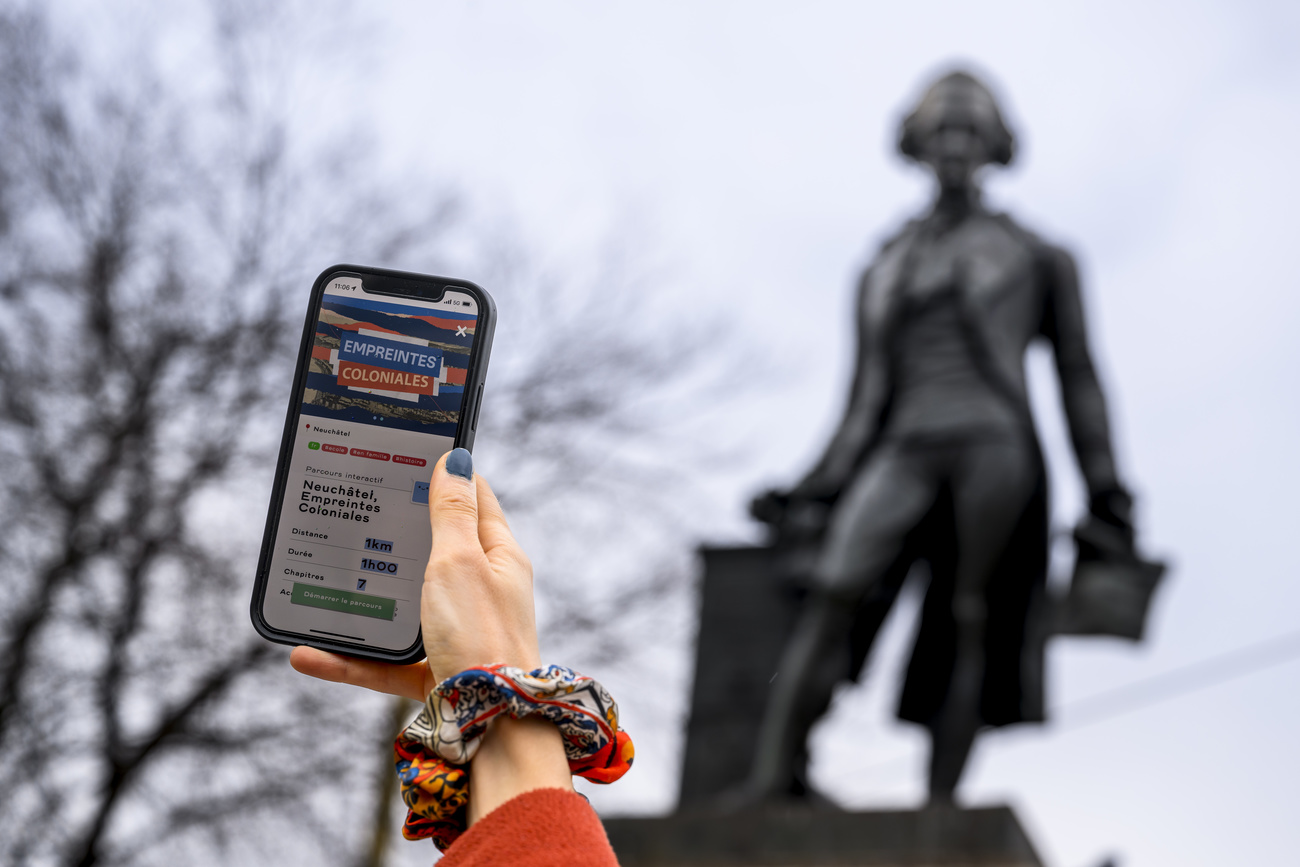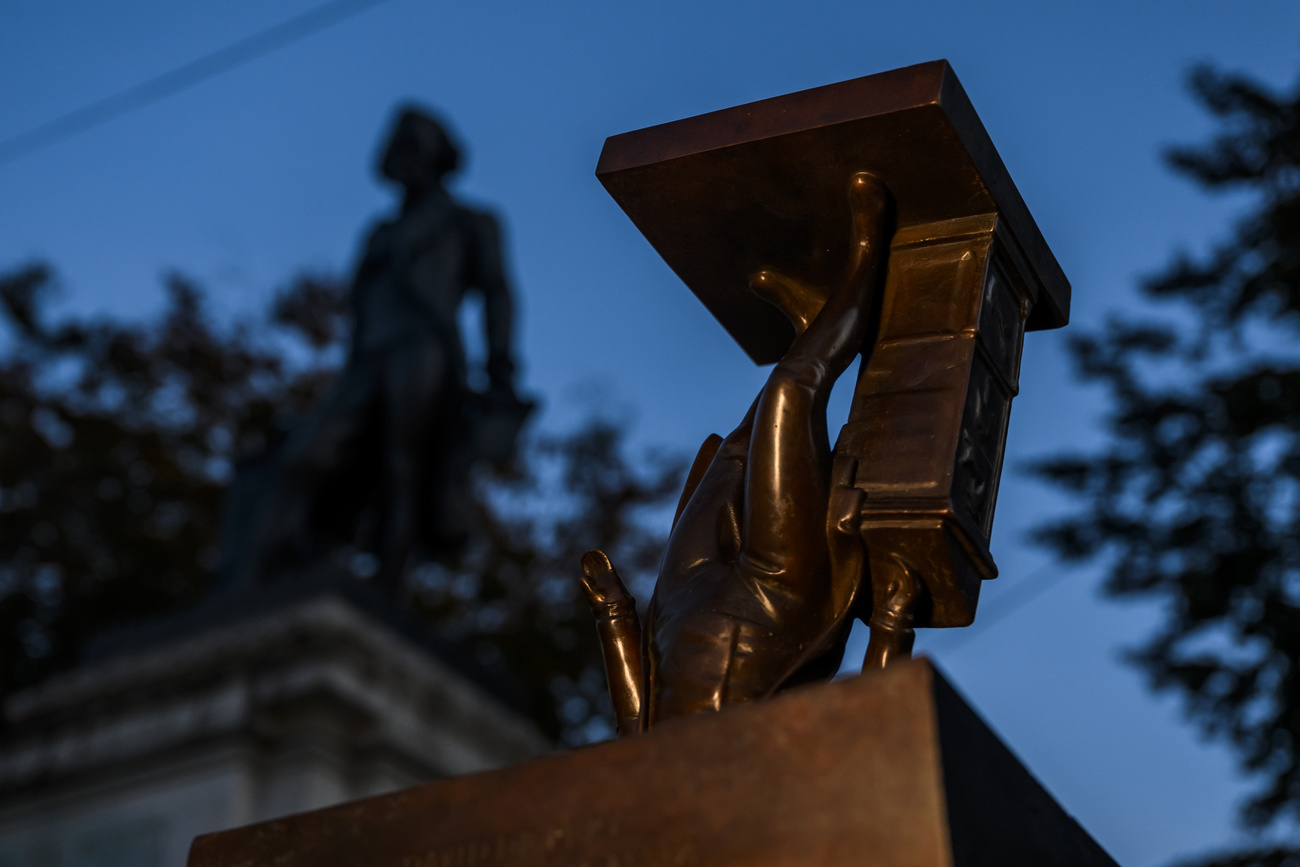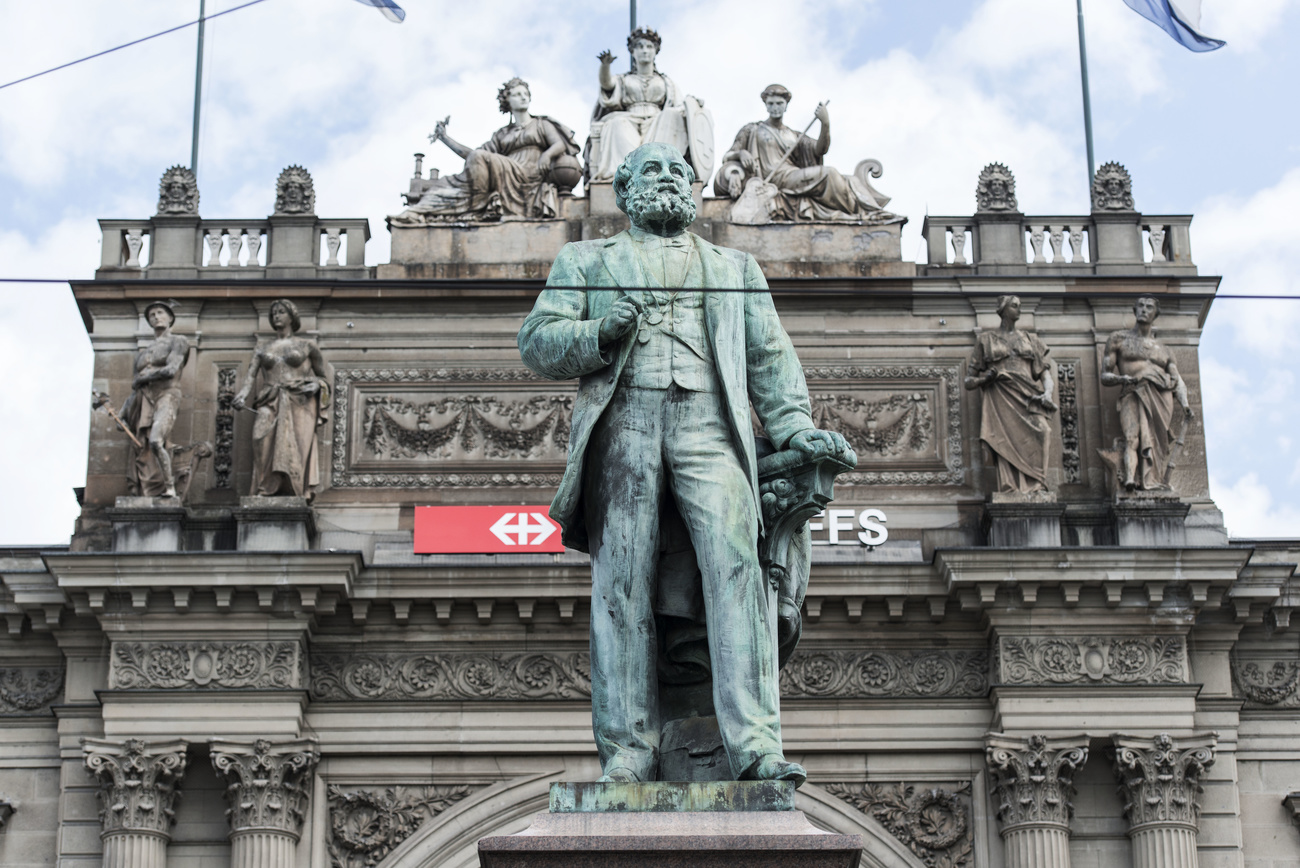
Swiss cities dust off their colonial past

The time has come for a reinterpretation of the history linking several Swiss cities to the colonial era. Short of destroying them, how should controversial symbols be addressed?
Statues, busts and streets bearing the names of great colonial-era fortunes abound in Switzerland. Ten years after the emergence of the Black Lives Matter movement, Swiss cities are still in the process of reframing their colonial history.
Between the 17th and 19th centuries, Zurich, Bern, Geneva and Neuchâtel benefited from the largesse of benefactors. But the names of these rich men continue to be directly or indirectly associated with the slave trade: these bankers, merchants and captains of industry owed their wealth to the “triangular trade”, through which manufactured goods were shipped from Europe to Africa, slaves were transported from Africa to America, and ships brought sugar, cocoa, coffee and tobacco from America to Europe.
Neuchâtel seeks inclusion
The Swiss cities at the time erected imposing monuments to benefactors as a sign of their gratitude. But these are now a burden on the urban landscape – especially as the names are often attached to important sites. Jacques-Louis de Pourtalès, who owned plantations in the West Indies and became rich by trading indiennes (printed or painted textiles), left such a deep impression on Neuchâtel that its main hospital still bears his name.
Another contentious site is the Hôtel DuPeyrou, named after Pierre-Alexandre DuPeyrou, a businessman born in Surinam who made his fortune in tobacco plantations. The splendid building bearing his name, owned by the city, now hosts banquets.
But it was a statue of the merchant David de Pury, smeared with red paint in the summer of 2020, that finally turned the winds of history in Neuchâtel. Petitions followed, demanding that a plaque be installed at the site of the monument to honour the victims of slavery.
Suddenly forced to confront this aspect of the city’s history, local authorities came up with a plan to achieve a better social and cultural inclusion of the city’s different population groups. “It was a unanimous decision by the city government to engage in this process in cooperation with civil society movements,” says Thomas Facchinetti, the official in charge of culture, integration and social cohesion in Neuchâtel. Since then, an explanatory plaque has been installed in front of the statue to clarify de Pury’s role. An exhibition at the history museum focused on maritime routes.
Adding insult to injury
The city has also invited young artists to create several works to form a “dialogue” between these and the five-metre-high de Pury bronze. But one of them, an upside-down, pocket-sized statuette of the racist glaciologist Louis Agassiz, is no match for de Pury’s statue. This figure irritates Kanyana Mutombo, secretary-general of the anti-racism organisation Carrefour de réflexion et d’action contre le racisme anti-Noirs (Crossroads for Reflection and Action Against Anti-Black Racism) in Geneva.

“With this kind of action, we add insult to injury,” he says. “Where is the dialogue between de Pury and those who made his wealth – the black slaves?”.
Mutombo opposes the removal of the statue. “It must retain its historical link to the city and the canton,” he says. “It cannot be torn down.” But he asks that “the other history, that of black slavery, be recognised as well”.
“It’s never too late for memory,” he adds.
In the final stage of its plan, the city inaugurated a tour at the end of March called Colonial Footprints. Guided by a mobile phone app, users stop at seven controversial sites, starting with the de Pury statue.
Cities take over
Neuchâtel is one of the first city governments to create this kind of educational tour. Other tours are on offer in Fribourg, St Gallen, Winterthur and Basel. Until now, the task of setting them up mainly fell to anti-racism groups. This is the case in Bern, where since 2005 the group Cooperaxion has campaigned to make politicians and inhabitants aware of their cities’ involvement in the triangular trade.
“In Geneva, where a report is expected soon on contested sites, the municipality is taking the same approach [as Neuchâtel] and a similar tour should follow,” says Matthieu Gillabert, a professor of contemporary history at the University of Fribourg.
“We have identified all the monuments and sites to determine which ones are problematic,” says Mutombo.
The presence of Carl Vogt, a 19th-century scholar who promoted racist theses, is particularly disturbing. Last September, the University of Geneva renamed a building that bore his name – on Carl Vogt Boulevard.
‘Invisible traces’ in Zurich
Zurich, Switzerland’s economic powerhouse, has also had its share of such benefactors. Alfred Escher, the founder of Credit Suisse, had the financial backing of his family, which had accumulated its wealth from slave labour on their plantations in North America. When his father Heinrich died, Escher inherited CHF1 million ($1.12 million) as well as property. In Zurich’s second district, for example, the exotic Belvoir Park was bequeathed to the city by the Escher family.

Here too, scholars have mapped out a route, called Colonial Zurich, similar to those in Bern and Neuchâtel. The tour begins at the Villa Patumbah, built in 1885 and one of the most opulent homes in Zurich. The man who commissioned it was Karl Fürchtegott Grob, whose fortune from Sumatran tobacco made him one of Zurich’s richest inhabitants in the 19th century.
This year, the municipal authorities took the bull by the horns with an exhibition on the traces of colonialism in the city, showing until mid-July. The exhibition, Blinde Flecken (Invisible Traces), is at Zurich’s City HallExternal link.
“Colonial connections contributed to the city’s rise as a financial metropolis. But this rise had its price,” the exhibition curators write in the catalogue. “Paradeplatz is the symbol of this ascent and of a system that brought prosperity, but also had its victims.” Debates on the “bitter legacy of cocoa” are scheduled. Teachers will also meet to discuss ways of transforming contemporary society by shedding critical light on this period.
Are reparations necessary?
All these efforts to restore the image of the cities “are not enough to make amends for the past, but it’s a start”, says historian and activist Hans Fässler. He has the support of high-profile figures such as the former Ticino prosecutor Dick Marty, the filmmakers Markus Imhoof and Fredi M. Murer, and the sociologist Jean Ziegler in his campaign as head of the Swiss Committee for Reparations for Slavery.
According to him, cities have been eager to revisit their histories. “Great progress has been made over the last 20 years in terms of post-colonial awareness,” he says. “But more can always be done. A majority of historians welcome this reinterpretation of the past, but many even go so far as to say history has arrived here, because this awareness didn’t exist before. But without Black Lives Matter, we wouldn’t have got to where we are.”
+Switzerland and its colonistsExternal link
The fact remains that confronting the past is a long and complex process. “And erasing these traces is never a solution. Each case must be taken individually when analysing memorials and problematic figures,” Fässler says. According to him, the options are either to put monuments in museums or to provide context on site.
“Slavery was a crime against humanity that requires material and immaterial reparation. The same goes for Switzerland, which benefited greatly from it,” he adds. “But these reparations must be the result of a dialogue between the descendants who benefited from this system and the descendants of those who were exploited.”
In Neuchâtel, Facchinetti says that to his knowledge, so far “no material claim has been made”. And the issue has not been discussed. Instead, he says, he observes “recognition and awareness at all levels”, particularly in schools.
Adapted from French by Catherine Hickley/gw

In compliance with the JTI standards
More: SWI swissinfo.ch certified by the Journalism Trust Initiative





























You can find an overview of ongoing debates with our journalists here . Please join us!
If you want to start a conversation about a topic raised in this article or want to report factual errors, email us at english@swissinfo.ch.